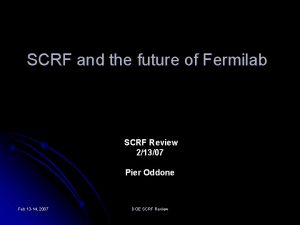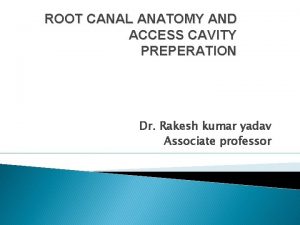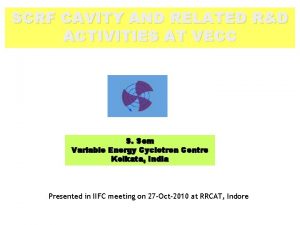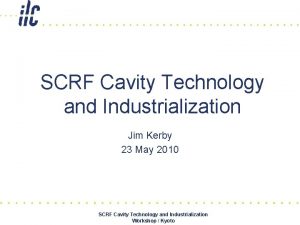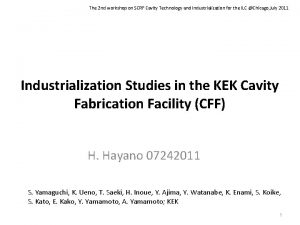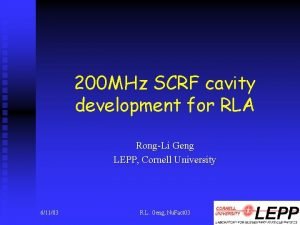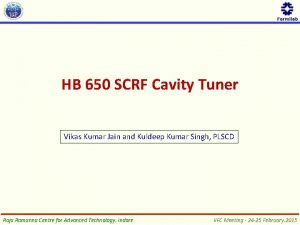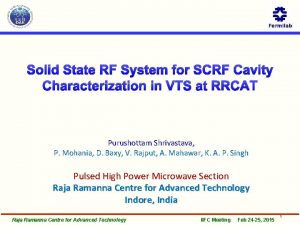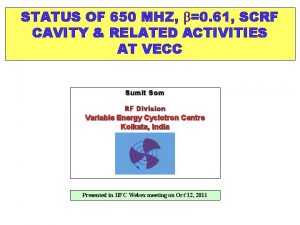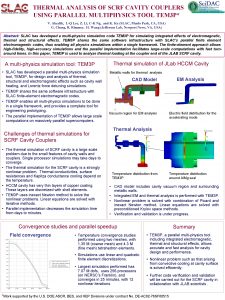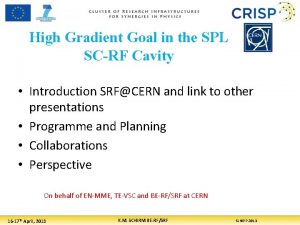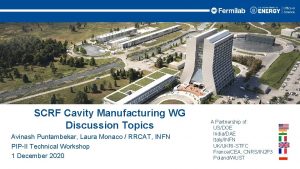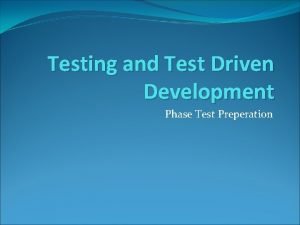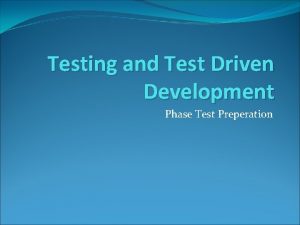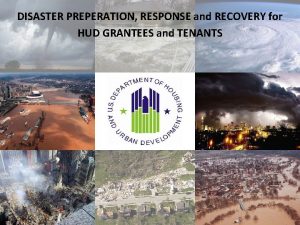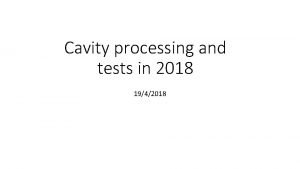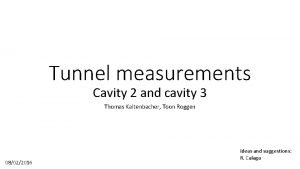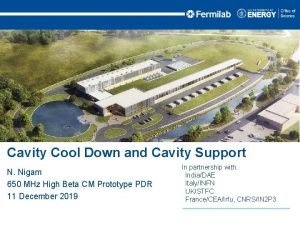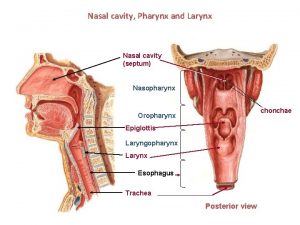SCRF Cavity RD Progress and Preperation for ILCML
































- Slides: 32

SCRF Cavity R&D Progress and Preperation for ILC-ML Gradient Decision A. Yamamoto, J. Kerby, R. Geng, and C. M. Ginsburg with thanks to the SCRF R&D team 7 January 2010 SCRF AAP Review Global Design Effort 1

Contents • Summary of TILC 09 -AAP Review, for Cavity • • SCRF Cavity Status ‘Global Database’ effort Gradient w/ respect to the RDR and SB 2009 Current R&D Efforts • SB 2009 / Gradient Integration Topics --- • NOTE: The SCRF Cavity R&D Status and plan will be the subject of a separate discussion in the GDE meeting, Beijing, March 2010 (tbc) and beyond. – This talk is a status report to prepare for further discussion 7 January 2010 SCRF AAP Review Global Design Effort 2

TILC 09 -AAP Review Reported by L. Lilje 7 January 2010 SCRF AAP Review Global Design Effort 3

TILC 09 -AAP Review Reported by L. Lilje 7 January 2010 SCRF AAP Review Global Design Effort 4

TILC 09 -AAP Review Reported by L. Lilje 7 January 2010 SCRF AAP Review Global Design Effort 5

TILC 09 -AAP Review Originally reported by H. Padamsee (TTC-08) 7 January 2010 SCRF AAP Review Global Design Effort 6

A Summary of TILC 09 -AAP Review 7 January 2010 SCRF AAP Review Global Design Effort 7

ILC Gradient R&D – Global Progress • First demonstration of 33 MV/m in, production-like, 9 -cell cavity processing and testing at ANL/FNAL & KEK in CY 09 Q 4 – Following DESY and JLab’s successes – Global competence in ALL regions emerging • Cavities (9 -cell) manufactured by US industry exceeds 35 MV/m – 3 out of 5 AES 2 nd production cavities 36 -41 MV/m – Close information feedback between lab and industry – Following successes in European industry (ACCEL/RI & ZANON) • Global cavity result database – First-pass yield 26% & second-pass yield 44% at 35 MV/m • July report was 22% and 33%, respectively. – ~60 9 -cell cavities expected in TDP-1 • Improved understanding of gradient limits (more at Beijing GDE meeting) 7 January 2010 SCRF AAP Review Global Design Effort 8

FY 09 Results from JLab/FNAL 7 January 2010 SCRF AAP Review Global Design Effort 9

Improved Understanding in Quench Limit • Routine monitoring: 9 -cell T-mapping and optical inspection – – – 9 -cell T-mapping being commissioned by LANL New 9 cell thermometry system in development at FNAL New insights from pre-cursor heating studies at JLab First predictive defect study at DESY Cornell 2 nd sound sensors, Cornell-OST’s, will be available for labs for quench detections – Many labs use “Kyoto/KEK camera” (JLab just received a loan unit) • New finding: many 9 -cell is quench limited at 20 -25 MV/m by only one defect in one cell with other superior cells already reaching 30 -40 MV/m – There may or may not be observable flaw in quench site – This seems to suggest we need to address material aspect besides processing and fabrication in TDP-2 – This also suggests some local repairing is needed for efficient raise of 2 nd pass gradient yield 7 January 2010 SCRF AAP Review Global Design Effort 10

Eaccmax(cell) by Pass-bands modes Meas. Reported by E. Kako (KEK), 0 ct. 2009. MHI-05 3 rd > 30. MV/m p mode; Eacc, max = 27. 1 MV/m Quench MHI-07 2 nd ~ 40. MV/m MHI-06 6 th Quench p mode; Eacc, max = 33. 6 MV/m 7 January 2010 SCRF AAP Review > 35. MV/m MHI-09 1 st > 35. MV/m Global Design Effort Quench by Field emission p mode; Eacc, max = 27. 7 MV/m Quench by Field emission p mode; Eacc, max = 25. 0 MV/m 11

Global Plan for SCRF R&D Year Phase Cavity Gradient in v. test to reach 35 MV/m Cavity-string to reach 31. 5 MV/m, with onecryomodule System Test with beam acceleration 07 2008 2009 TDP-1 Process Yield 50% 2011 2012 TDP-2 Production Yield 90% Global effort for string assembly and test (DESY, FNAL, INFN, KEK) FLASH (DESY) , NML (FNAL) STF 2 (KEK, extend beyond 2012) Production Technology R&D Preparation for Industrialization 7 January 2010 SCRF AAP Review 2010 Global Design Effort 12

Global Database Effort • Following the Spring ‘ 09 Reviews, the need to establish a global database was noted – – – Common data sample, well defined data cuts Easily reproducible plots Data entry rules for reliable and reproducible results Well defined data fields No private/sensitive vendor data Regular updates at predetermined times • As part of the S 0 effort, a database team was established, and led by – C. M. Ginsburg (FNAL) and including – S. Aderhold (DESY), Z. Conway (Cornell), R. Geng (S 0 leader, Jlab), and K. Yamamoto (KEK) was established • A 6 month timeline for implementation was developed • DESY management agreed to provide support 7 January 2010 SCRF AAP Review Global Design Effort 13

Cavities in the current dataset • 27. Oct. 2009 Excel spreadsheet contains data from all three regions, from the last few years – KEK [5 cavities]: [MHI 005: MHI 009] – JLab, Cornell, Fermilab [18 cavities]: [A 5: A 9], [TB 9 ACC 010: TB 9 ACC 015], [AES 001: AES 004], [TB 9 AES 005: TB 9 AES 006], JLAB-2 – DESY [53 cavities]: [AC 112: AC 129], [Z 130: Z 145], [AC 146: 150] (Production batches 5, 6, &7 are represented) and [Z 88, Z 93, Z 97, Z 98, Z 100: Z 104, Z 106: Z 110] (Production 4) • 11. Dec. 2009 update – Updates from all three regions – Americas [+4 cavities]: TB 9 AES 008, TB 9 AES 009, TB 9 AES 010, TB 9 ACC 016 1 st pass 7 January 2010 SCRF AAP Review Global Design Effort 14

Production Yield Plot - Method • Database version 11. Dec. 2009 • Cuts – Cavity from vendors who have manufactured a cavity that has surpassed 35 MV/m in vertical test: • ACCEL or ZANON or (AES SN>=5) – Fine-grain cavity – Use the first successful (= no system problem/limitation) test – Standard EP processing: no BCP, no experimental processes • Defined as JLab#1, DESY#2 (weld tank before test), DESY #4 (weld tank after test) • Ethanol rinse and 120 C bake required for DESY cavities – (Ignore test limitation) • Also known as “first-pass” • Include binomial errors 7 January 2010 SCRF AAP Review Global Design Effort 15

“Up-to-second-pass” Production Yield Plot - Method • • Database version 11. Dec. 2009 Cuts – Cavity from vendors who have manufactured a cavity that has surpassed 35 MV/m in vertical test: • ACCEL or ZANON or (AES SN>=5) – Fine-grain cavity – Use the first successful (= no system problem) test – Standard EP processing: no BCP, no experimental processes • Defined as JLab#1, DESY#2 (weld tank before test), DESY #4 (weld tank after test) – (Ignore test limitation) – Second pass • if (Eacc(1 st successful test)<35 MV/m) then – if (2 nd successful test exists) then » – else » – • • plot nothing [assume 2 nd test didn’t happen yet] endif else – • plot 2 nd test gradient plot 1 st successful test gradient endif Include binomial errors 7 January 2010 SCRF AAP Review Global Design Effort 16

Database Snapshot Acknowledge DESY support 7 January 2010 SCRF AAP Review Global Design Effort 17

Compare 1 st and 2 nd pass yields updated, Dec. 2009 1 st pass 2 nd pass improvement degradation Performance typically improves after 2 nd pass 7 January 2010 SCRF AAP Review Global Design Effort 18

Summary of Cavity Gradient Status • Global Database has been created – Consistent, reproducible plots incorporating worldwide data • Production, 2 nd pass yield of 44% for vendors with a cavity >35 MV/m in vertical test – Q 0 goals met by all cavities, >35 MV/m--efforts will continue on this aspect as well • Considerable number of cavity tests coming in 2010 – Infrastructure, cavity orders in place – Fermilab completed 6 VTS test cycles in December • Continued push to TDP goals, through better control of fabrication and processing – Better diagnostic equipment in place • Extension of understanding to maximize machine performance economically in final design – Improved technical understanding and increased statistics provide basis for updating of industrialization model 7 January 2010 SCRF AAP Review Global Design Effort 19

SCRF Cavity Gradient in SB 2009 and Preparation for ILC-ML Gradient Decision • Re-evaluation of the design accelerating gradient is required during TDP 2, based on – Statistical cavity performance (R&D results), i. e. expected/projected yield for cost-optimized mass production – Required operational overhead of installed cavities in linac (under full beam loading) • • • SB 2009 WA-1 is to maintain the RDR value of 31. 5 MV/m (Q 0 ≥ 1× 1010) pending final and thorough review of R&D status – Determines length of main linac, in SB 2009 (CFS requirements) Unlike RDR, propose to adopt variable power distribution for HLRF to allow for spread in accelerating gradient of individual cavities – Maximize average accelerating gradient (better ‘yield’) – Has impact on required RF power overhead and efficiency – Overall cost benefit Acceptable performance spread of cavities about the average still remains to be determined – Expect approximately ± 10~ 20% 7 January 2010 SCRF AAP Review Global Design Effort 20

Alternative Yield Plot Analysis originated by N. Walker Dec 2009 Data: 1 st +2 nd Pass, 1 st pass cut 35 MV/m, vendors w/ 1 cavity > 35 MV/m 45, 0 40, 0 Gradient MV/m 35, 0 30, 0 Average Gradient 25, 0 max 20, 0 min <36 MV/m> 27. 9 -41. 8 MV/m 64% yield 15, 0 10, 0 5, 0 >35 MV/m 35 -41. 8 MV/m 44% yield 7 January 2010 SCRF AAP Review 0, 0 0% 20% 40% 60% 80% 100% Yield -Yield: estimated assuming a specific lower cut-off in cavity performance, below which cavities are assumed 'rejected’. - Error bar: +/- one RMS value (standard deviation of the population) of the remaining (accepted) cavities (gradient above cut-off). - Additional bars (min, max) indicated the minimum and maximum gradients in the remaining cavities. Global Design Effort 21

Flattop Operation with a Spread of Cavity Gradients Fractional Size reported by C. Adolphsen Qext Input Power Reflected Power Gradient 31. 5 MV/m Average 24. 5 MV/m 29. 8 MV/m 38. 5 MV/m

The Next Battles (1): Eliminate the Yield Drop near 20 MV/m Despite increased acceptance thanks to more flexible HLRF 31. 5+/-20% 7 January 2010 SCRF AAP Review Global Design Effort 23

The Next Battle (2): Further Reduce Field Emission up to 40 MV/m Flexible HLRF opens up possibility of some individual cavity operations up to 38 MV/m 31. 5+/-20% - Operation at >35 MV/m significantly raises the bar for FE suppression. - Recent R&D has shown proof of existence of “FE-free” 40 MV/m in 9 -cell vertical test – further R&D is needed for reliable FE suppression 7 January 2010 SCRF AAP Review Global Design Effort 24

Progress and Prospect of Cavity Gradient Yield Statistics PAC-09 Last/Best May 2009 FALC 1 st Pass Jul 2009 ALCPG 2 nd Pass Oct 2009 Current Coming Dec 2009 Prod/Test Research Jun 2010 cavities DESY 9 (AC) 16 (ZA) 8 (AC) 7 (ZA) 14 (AC/ZA) 10 -6 (Prod-4) 5 8 (large grain) JLAB 8 (AC) 7 (AC) 4 (AE) 1 (KE-LL 5) 1 (JL-2) 7 (AC) 5 (AE) 1 (AC) 12 (RI) 6 (AE) 2 (AC) 6 (NW) FNAL/ANL/ Cornell KEK/IHEP /PKU Sum 39 22 G-Sum (including large-G) (4 -4: MH) 5 -5 (MH) 2 (MH) ~5 (LL) 1 (IHEP) 2 (PKU) 21 21 -11 27 ~ 22 42 -11 = 31 69 -11=58 Statistics for Production Yield in Progress to reach ~ 60, within TDP-1. We may need to have separate statistics for ‘production’ and for ‘research’, 7 January 2010 SCRF AAP Review Global Design Effort 25

R&D Goals & ILC Operational Gradient • The RDR has a gradient goal of 35 MV/m such that a machine performance based on 31. 5 MV/m (-10%) may be achieved • The S 1 and S 2 goals are both set at 31. 5 MV/m • This 10% reduction was assumed (in Snowmass, 2005) – to include limitations due to both ‘final assembly problems’ and required ‘machine operational overhead’ • In addition to continued efforts on cavity performance, TDP-2 gives several opportunities to further investigate and quantify the actual required value, and thus the machine design – – FLASH NML STF 2 Horizontal cavity tests 7 January 2010 SCRF AAP Review Global Design Effort 26

S 1 Goal: Achieved at DESY/XFEL - PXFEL 1 gradient at CMTB achieved < 32 MV/m> - FLASH plan to operate it at 30 Mv/m First XFEL prototype module exceeds 31. 5 MV/m average - Module will see beam in FLASH in 2010 (av. of 30 MV/m) - Cryostat (cryomodule cold-mass) contributed by IHEP, in cooperation with INFN 7 January 2010 SCRF AAP Review Global Design Effort 27

Subject to be studied in TDP-2 - Balance between R&D target values and Operational parameters Will be reviewed after S 1 experience -System design should require reasonable margin for the individual component and the system operation S 1 (~ Component performance) > ILC-Acc. Operational Gradient RDR/SB 2009 Re-optimization required with cautious, systematic design R&D goal: S 0 35 (> 90%) 35 MV/m (> 90 %) Keep it, and forward looking S 1 (w/o beam) 31. 5 in av. need: > 31. 5 in av. , to be further optimized 31. 5 in av. S 2 (w/ beam acc. ) 31. 5 in av. > 31. 5 in av. ILC: operational gradient 31. 5 in av. 7 January 2010 SCRF AAP Review (+/- 10 ~ 20 %) Global Design Effort or: < 31. 5 in av, , to be further optimized 28

Summary • In SB 2009, ILC operational field gradient left unchanged – for CF&S study to enable to stay at 31 km in ML tunnel length and to be consistent with 250 Ge. V beam energy, • SCRF cavity gradient R&D Goal – Kept to be 35 MV/m (at Q 0 = 8 E 9) with the production yield of 90 %, – Global data base appreciated to continue for monitoring the progress, • Spread of cavity gradient effective to be taken into account – to seek for the best cost effective cavity production and use, – Final acceptable range requires confirmation from RF effort, • Re-optimization required, to decide ILC operational gradient – to have adequate balance/redundancy between the ‘R&D gradientmilestone’ and the ‘ILC operational gradient’ including ‘cryomodule operation margin’ and ‘HLRF/LLRF adjustability’ for stable and sufficiently high ‘availability’ with risk mitigation. 7 January 2010 SCRF AAP Review Global Design Effort 29

Additional Information 7 January 2010 SCRF AAP Review Global Design Effort 30

A Satellite Meeting at IPAC-2010 Industrialization of SCRF Cavities Date : Place: Organized by: May 23, 2010, a full-day meeting, prior to IPAC-2010 Int. Conf. Center, Kyoto, Japan ILC-GDE Project Managers, Objectives and Plan: • • To discuss and exchange information on preparation for the ‘ILC SCRF Cavity’ industrialization between industries and laboratories, Industrialization plan to be reported by laboratories, and comments/advices given by industries, Announcement sent/made to major cavity vendors, RI, Zanon, AES, Niowave, PAVAC, MHI, other SCRF industries, and ILC-SCRF institutions, A, Yamamoto, 09 -11 --02 ILC-PAC: SCRF Report 31

Additional Report: S 1 -Global Progress All Components arrive in Japan, Dec. 2009 • Global effort for cryomodule test – – INFN: Cryomodule DESY: 2 cavities FNAL/JLab: 2 cavities KEK: 4 cavities, Cryomodule Delivered to KEK on Dec. 25, 2009 A, Yamamoto, 09 -11 --02 ILC-PAC: SCRF Report 32
 Orbital cavity nasal cavity ventral cavity oral cavity
Orbital cavity nasal cavity ventral cavity oral cavity Job interview preperation
Job interview preperation Physical progress and financial progress
Physical progress and financial progress Vertebral cavity
Vertebral cavity Nine regions of the abdominopelvic cavity
Nine regions of the abdominopelvic cavity Peritoneum
Peritoneum Abdominal part of esophagus
Abdominal part of esophagus Fspos
Fspos Typiska novell drag
Typiska novell drag Tack för att ni lyssnade bild
Tack för att ni lyssnade bild Returpilarna
Returpilarna Varför kallas perioden 1918-1939 för mellankrigstiden
Varför kallas perioden 1918-1939 för mellankrigstiden En lathund för arbete med kontinuitetshantering
En lathund för arbete med kontinuitetshantering Kassaregister ideell förening
Kassaregister ideell förening Personlig tidbok fylla i
Personlig tidbok fylla i A gastrica
A gastrica Förklara densitet för barn
Förklara densitet för barn Datorkunskap för nybörjare
Datorkunskap för nybörjare Stig kerman
Stig kerman Mall debattartikel
Mall debattartikel Delegerande ledarstil
Delegerande ledarstil Nyckelkompetenser för livslångt lärande
Nyckelkompetenser för livslångt lärande Påbyggnader för flakfordon
Påbyggnader för flakfordon Vätsketryck formel
Vätsketryck formel Offentlig förvaltning
Offentlig förvaltning Kyssande vind
Kyssande vind Presentera för publik crossboss
Presentera för publik crossboss Teckenspråk minoritetsspråk argument
Teckenspråk minoritetsspråk argument Kanaans land
Kanaans land Klassificeringsstruktur för kommunala verksamheter
Klassificeringsstruktur för kommunala verksamheter Luftstrupen för medicinare
Luftstrupen för medicinare Bästa kameran för astrofoto
Bästa kameran för astrofoto Centrum för kunskap och säkerhet
Centrum för kunskap och säkerhet

































